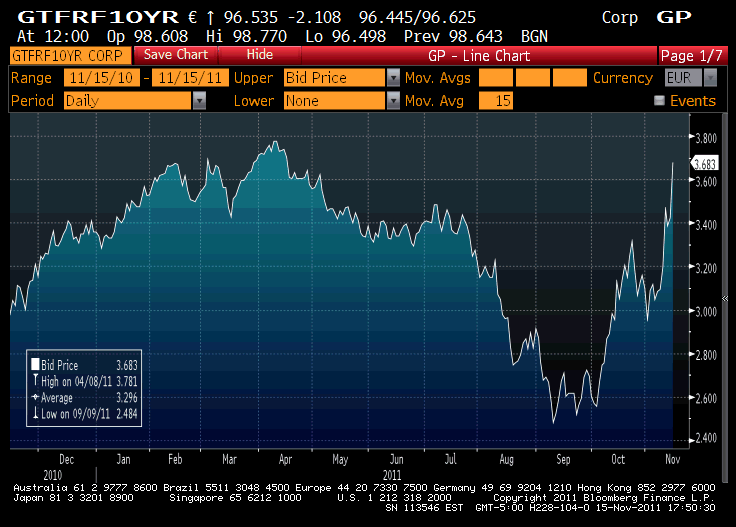The equity risk premium Land of the free lunch
Post on: 4 Август, 2015 No Comment

Land of the free lunch
Add this article to your reading list by clicking this button
ENGLAND and America are two countries separated by a common language, said George Bernard Shaw. Certainly, on my trip to the US last week, I found a gulf between my natural British pessimism and the can-do American spirit. In particular, this relates to expectations of future returns.
The standard assumption for pension fund returns is around 8% per annum. This seems to be based on past experience*. Corporate pension funds have a standard 60/40 asset split; state funds may be 70/30 (instructive that they are taking more risk on the taxpayers’ dime). Treasury bonds yield 3% or so, which means the fixed income portion of a state’s portfolio is generating 0.9%; the equity portion has to generate the other 7.1%, which equates to 10% a year.
How likely is that? It is a truism to say that equity returns come from three sources; the dividend yield, dividend growth and the change in the price/dividend ratio. This latter figure reflects the re-rating or de-rating of the market. If the dividend is unchanged, then a shift in the market’s yield from 3% to 2% means a 50% capital gain. Figures from Elroy Dimson, Paul Marsh and Mike Staunton of the London Business School, in associaiton with Credit Suisse, show that global real equity returns over more than a century have averaged 5.5%. This has been made-up of an intitial yield of 4.1%, real dividend growth of 0.8% and a re-rating effect of 0.5% a year (the US figures are pretty much the same). As you can see, the initial yield is crucial.
So can we get to 10% nominal from current conditions? The S&P 500 currently yields 2.2%. Let’s add in a further 1% for buy-backs (which are highly variable). Real dividend growth? Let us assume it doubles its historical average to reach 2% a year. And let us be bold and guess that, even though the market has a lower yield than the average, it does not get de-rated back to the mean, so there is no loss from the third factor. All that gets to 5% real growth; add in 2.5% for inflation (as measured in the bond market) and we get to 7.5% nominal return, before costs. Using those numbers a 70/30 equity/bond portfolio would generate a return of 6%.
What if inflation were higher, say 5%, then could equities generate the 10% return? Alas, it’s not that easy. Equities wouild be de-rate in such circumstances; even a move in the yield from 2% to 4% implies a 50% fall in capital values. The bond part of the portfolio would lose money as well.
But that kind of reasoning tended to draw blank stares from my American hosts. Their reasoning was that equities have always beaten bonds (except in the last decade) by a wide margin and will continue to do so. That has been true of the US, where equities have always produced real returns over 20 years, as the LBS/Credit Suisse data show. But it has not been true in Britain; and in France, there have been periods of 60 years or more when equities have not produced positive real returns.
In short, America is the ultimate example of survivorship bias. Go back to 1900 and you might have picked Argentina or Russia as emerging nations with the ability to rival the US but each proved to be a huge disappointment. The equity risk premium is just that; compensation for risk. It cannot be guaranteed.
*Of course, the higher the assumed return, the less the sponsor has to contribute, so there is a bias towards optimism.
UPDATE: Just to respond on the discount rate front, the unions in Illinois were very keen to tell me their pensions were constitutionally protected. In Vallejo, California, bondholders are taking a hit thanks to the ciry’s troubles, but not pensioners. So a benefit that can’t be cut looks like a pretty solid obligation to me and thus must be discounted at the risk-free rate. After all, companies borrow in the form of long-term bonds; doubtless they expect to invest that money and earn a higher return. But they can’t say the bonds should only be valued at 50 cents on the dollar on their balance sheets, because they expect to earn a higher return; the fraud squad would be after them in 5 minutes.
UPDATE 2: On the truism point, this reasoning applies at the market level (this is known as the Gordon growth model). Yes, in terms of individual stocks, owning a dividend-less share implies that the company will start paying dividends later (as Nicrosoft did) or that the company can be broken up (or taken over) and the cash returned to investors. On inflation, the states use nominal numbers which is why I did. There are limited cost-of-living adjustments in most cases. In theory, the problem could be inflated away (creating a problem for pensioners, of course) but the states cannot generate inflation on their own.
Previous
Culture shock: Beck to the future
Next
Economic data: Too much seasoning














